Mugicha or Japanese Barley Tea is a caffeine-free beverage made from roasted barley grains. It has a coffee-like toasty flavor with a hint of bitterness and a dry finish. Served chilled or hot, it’s a refreshing year-round drink for all ages!
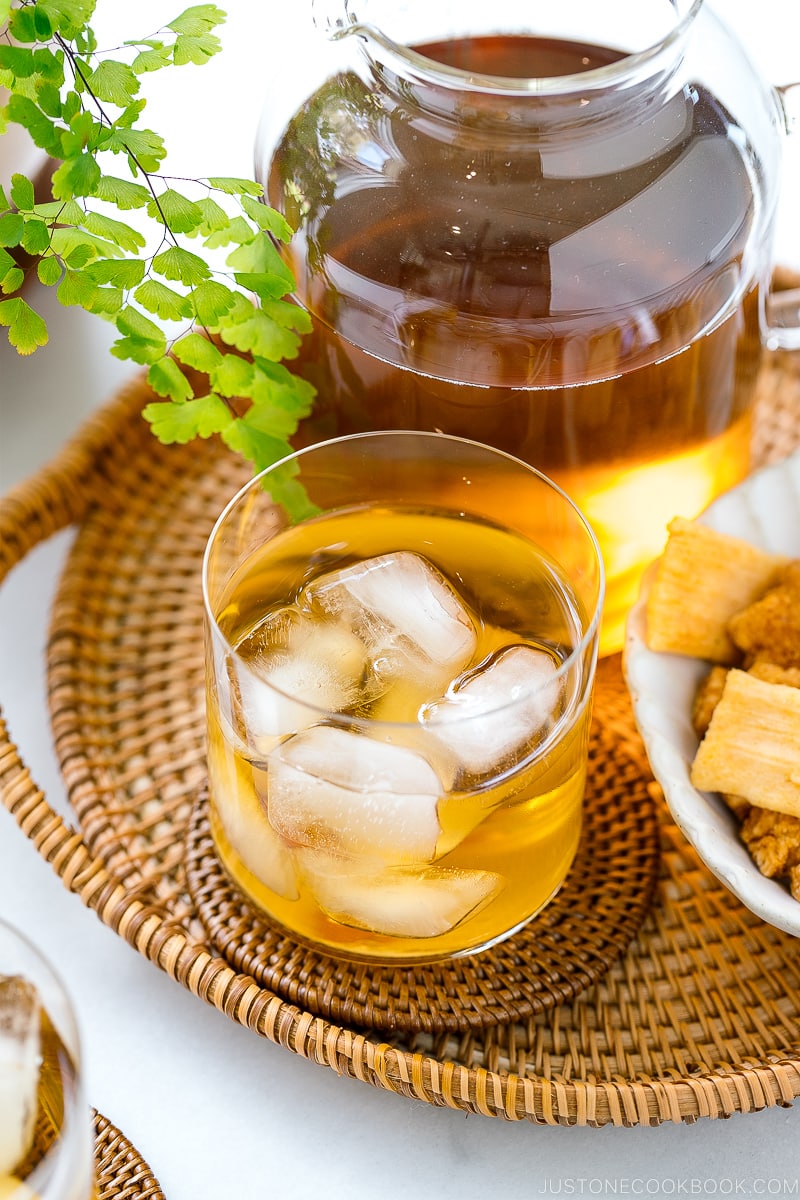
What was your summer drink growing up? Lemonade, watermelon juice, or maybe Capri Sun? Most Japanese kids enjoy drinking Mugicha (麦茶), chilled roasted barley tea.
We carry an insulated bottle filled with cold mugicha and ice to summer activities, camping, and playing in the playground. Cold mugicha is a lifeline to surviving brutally hot and muggy Japanese summers.
My children also grew up drinking mugicha and it’s a wonderful drink to keep in your refrigerator all summer long (and we drink it hot in winter too).
Table of Contents
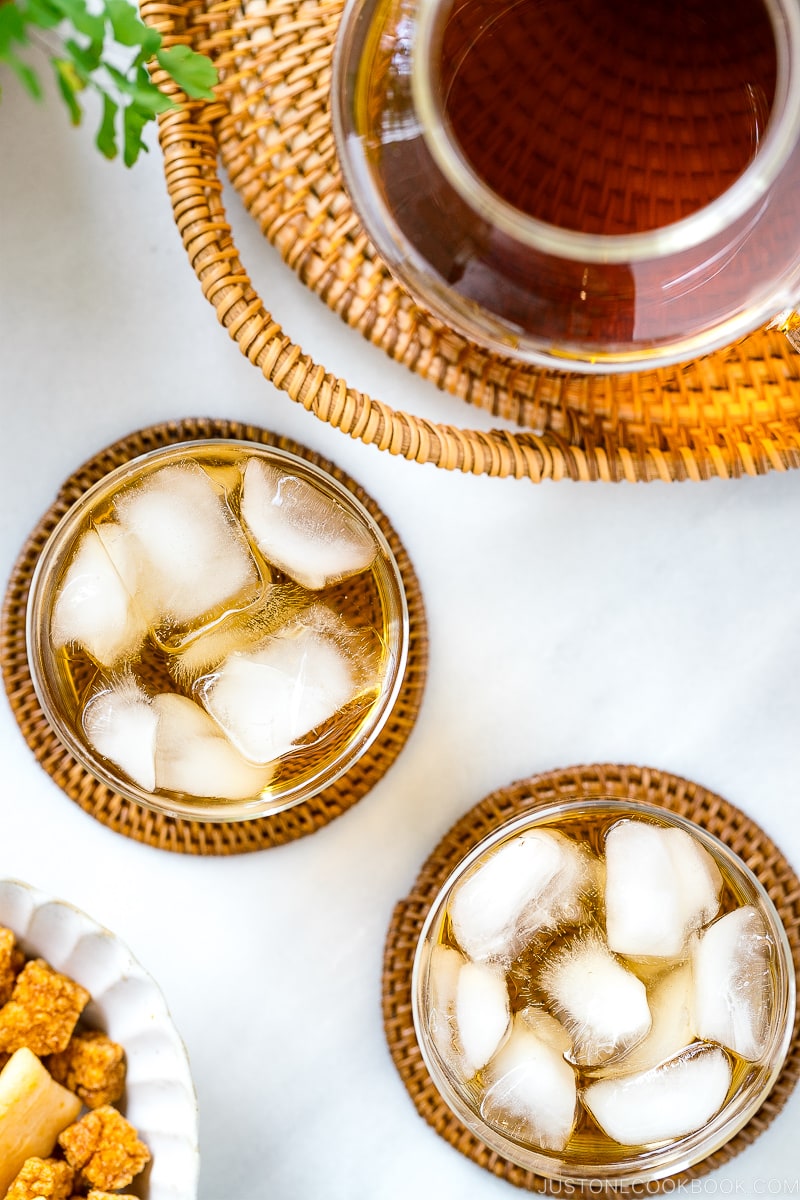
What is Mugicha?
Mugicha (麦茶, むぎ茶) is made from roasted unhulled barley grains that is served both hot or cold. Technically, it’s a tisane (herbal tea) and not from the leaves of Camellia sinensis, the tea leaves which is processed to make black tea, green tea, and oolong tea. There’s nothing better than quenching your thirst with ice cold mugicha on a hot day!
It’s a homey drink that you won’t find served at high-end restaurants but at ramen shops and casual eateries in Japan. Mothers in Japan give sips of mugicha to their babies and toddlers as an alternative to plain water.
It’s also a beloved drink called boricha in Korea and mai-cha or damai-cha in China.
If you are gluten sensitive or have celiac disease, mugicha is not for you.
Why Should We Drink Mugicha?
- Caffeine-free – Yes, kids drink diluted mugicha before turning 1 year old!
- Super easy to make – Just drop the tea bag into a jug and let it steep in the water!
- A great alternative to plain water and sugary drinks – It’s flavorful without sweeteners!
- Offers many great health benefits like vitamins and antioxidants
What Does It Taste Like?
The tea has a toasty taste and smells slightly similar to roasted coffee beans with mild bitter undertones. It’s smooth and subtle so kids also enjoy it.
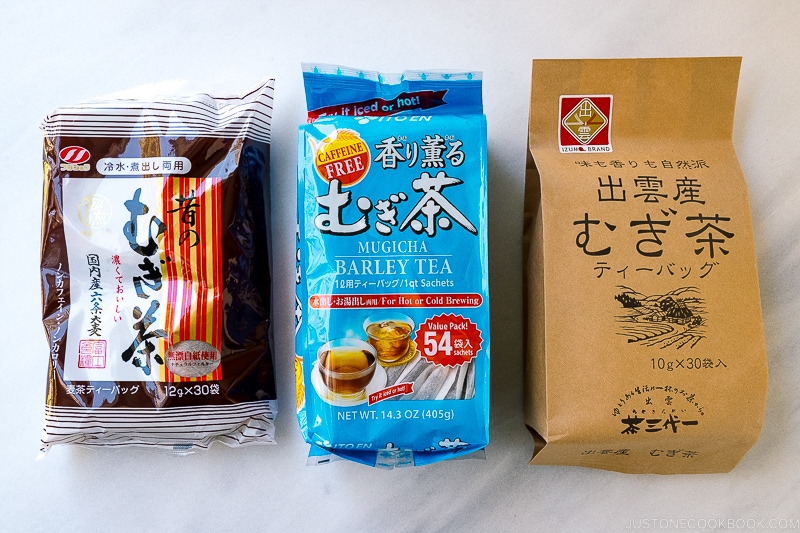
Where To Buy Mugicha
You can find mugicha tea bags at Japanese, Korean, and Asian supermarkets. You may also find it at gourmet stores and health food stores sold as “barley tea.” Amazon sells the Itoen brand Mugicha (the blue package above).
Mugicha is also sold ready-to-drink in bottle format as well (see this product).

Health Benefits of Mugicha
There’s so much goodness in a glass of mugicha. Here are just a few of the nutrients in mugicha.
Aids digestion
Mugicha is a natural antacid that helps relieve painful heartburn and acid reflux. The antioxidants in barley can also relieve stomach cramps and nausea. Barley is also high in dietary fibers, which regulate bowel movement, prevent constipation, and keep your gut clean.
Keeps your body hydrated and helps with detoxification
The cooling effect in barley tea is believed to help regulate your body temperature on hot summer days and hence keep you hydrated. The vitamins and minerals present in the barley help cleanse and detoxify the body.
Boosts skin health
Traditional Eastern medicine often recommends herbal tea for boosting skin health. Packed with antioxidants, barley tea is great for protecting the skin by reducing free radical production and pigmentation.
Helps you wind down
Barley contains significant levels of melatonin, a hormone naturally found in the body that help you feel relaxed and sleepy. Melatonin works to regulate the body’s internal clock by regulating sleep cycles.
In short, mugicha is amazing!

How to Brew Mugicha
You can make mugicha in both cold and hot methods.
Cold Brew Method
- Put a packet of mugicha in a measuring cup and pour 1/4 cup (60 ml) of hot water.
- Let the packet steep for 2 minutes.
- Transfer the packet and tea into a large pitcher and add 1 QT (1 L) of cold water.
- Let the packet steep for 2 hours in the refrigerator and take out the spent packet.
- Serve the mugicha over ice cubes in individual glass cups.
Hot Brew Method
- Bring 1 QT (1 L) of water and a packet of mugicha in a kettle to a boil.
- Once boiling, lower the heat to simmer and let the packet steep for 3-5 minutes.
- Remove the packet and mugicha is ready to serve hot in individual teacups.
You can also serve hot brew mugicha cold if you like. Let the kettle cool quickly by placing the kettle in a large bowl filled with ice water. *Especially in the summertime, you want to cool it as soon as possible to avoid spoiling the mugicha. Once the mugicha is completely cool, transfer it to a large pitcher and keep it in the refrigerator until cold.
How Long Does Mugicha Last in the Fridge?
You can store mugicha for up to 2-3 days in the fridge.
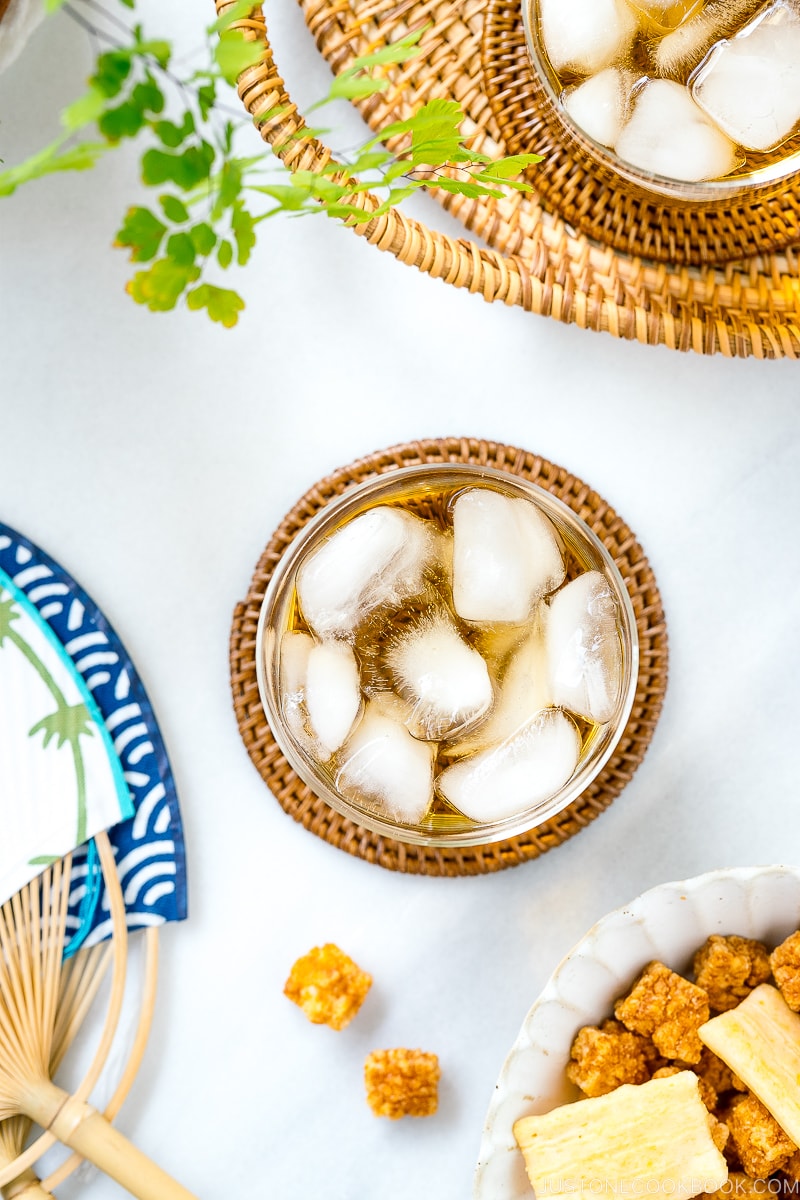
Other Delicious Summer Drinks
- Cold Brew Hojicha
- Cold Brew Green Tea
- Japanese Cream Soda
- Watermelon Juice
- 3 Easy Homemade Lemonade Recipes
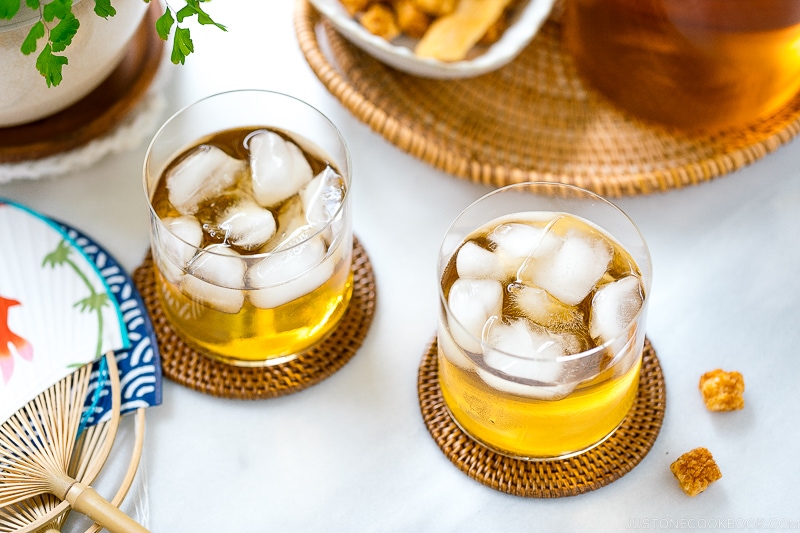

Cold Brew Mugicha (Japanese Barley Tea)
Ingredients
- 1 tea bag Japanese barley tea (mugicha)
- ¼ cup boiling water
- 1 QT room temperature or cold filtered water
Instructions
- Before You Start…Please note that this recipe requires 2 hours of steeping time.
- Get a package of mugicha tea bags.

- In a measuring cup, place 1 tea bag Japanese barley tea (mugicha) and add ¼ cup boiling water. Let it steep for 2 minutes. Quickly hydrating and steaming the dry tea with boiling water helps release the flavor of the barley.
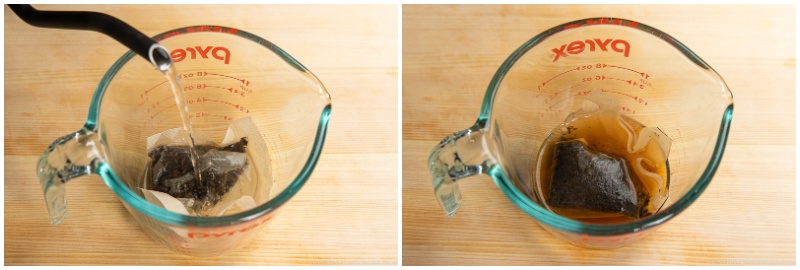
- Pour the concentrated tea and the tea bag into a large pitcher.
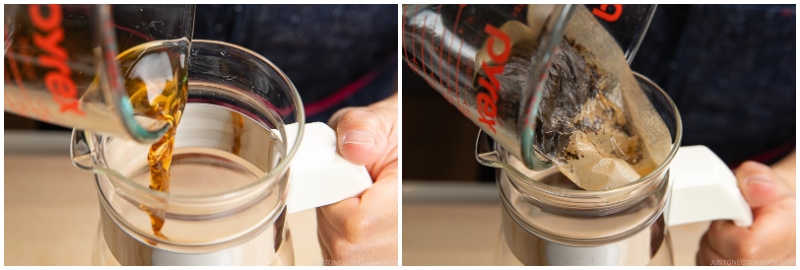
- Add 1 QT room temperature or cold filtered water and let it steep for 2 hours in the refrigerator.
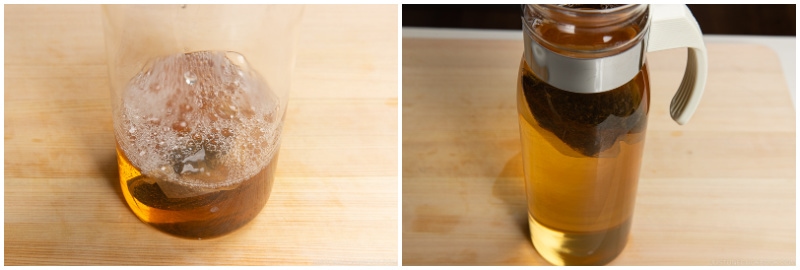
- Discard the tea bag and it‘s ready to serve.
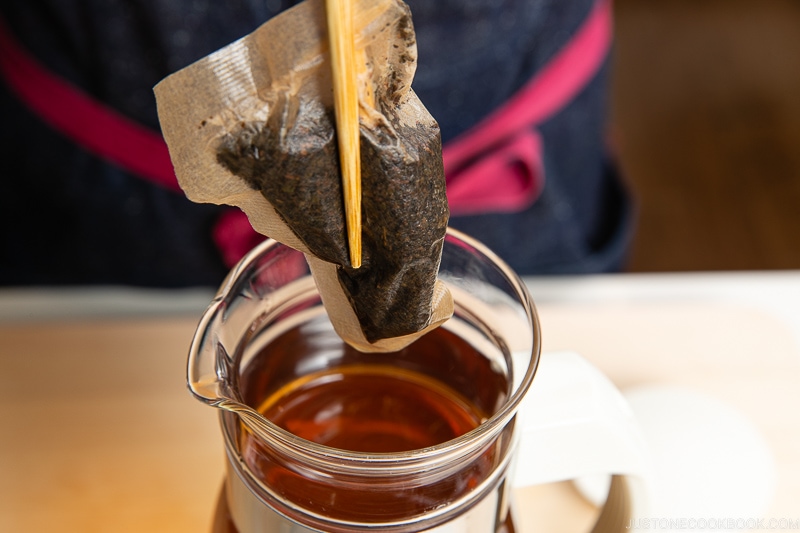
To Serve
- Serve the mugicha over ice cubes in individual glass cups.

To Store
- You can store mugicha for up to 2–3 days in the refrigerator.
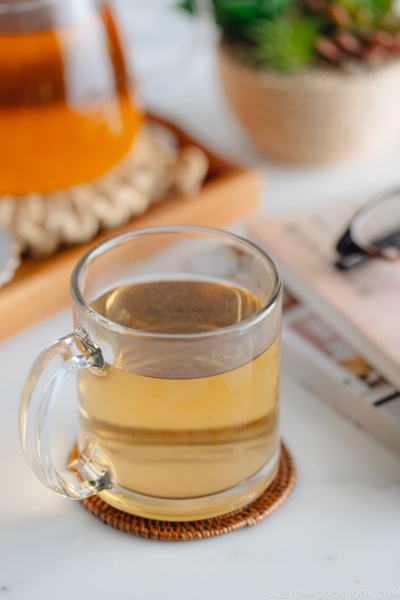
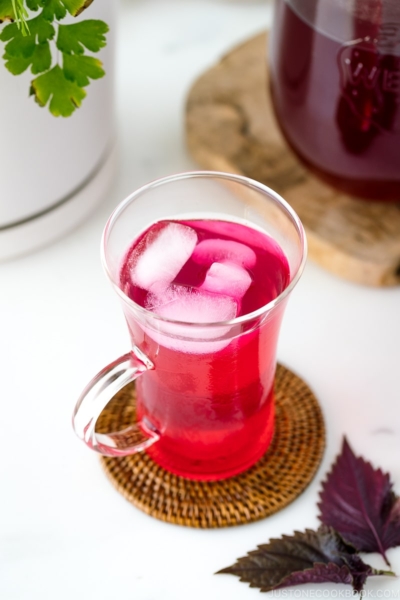
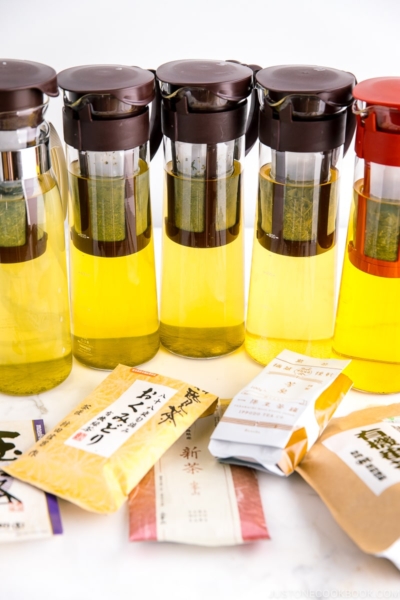





I got some from Amazon (the blue bag). I find myself making a new batch every other day because I can’t stop drinking it! It’s delicious! And I can drink it while I’m fasting, because it has no calories, so it’s perfect. I tried to have my mom try it, but she complained about it tasting like yeast. Lol
Hi, Aubrey! We’re glad to hear you enjoyed Mugicha.
Thank you for trying Nami’s recipe and providing us with feedback from you and your mother.😃
I thought you might like to know the etymology; “tisane (n.)medicinal tea, any concoction with medicinal properties, by 1931, from French tisane; earlier ptisan (14c.), from Latin ptisana, from Greek ptisanē “crushed barley,” related to ptissein “to winnow, crush, peel”
‘Barley tea is most definitely a “tisane”!
Cheers.
Hi Keith! Thank you for sharing this!🙂
I love barley tea, and had completely forgotten about it until the newsletter reminded me!
I was able to get a package of the tea bags at Daiso (one recently opened near me! Love it!)
I actually make a half-and-half blend of iced tea using the barley tea and Earl Grey. The Earl Grey adds an herby/citrusy note, and it is VERY refreshing!
Hi Donald! Thank you for reading Nami’s post!
Wow! Mugicha and Earl Grey! It’s very interesting. We will give it a try! 🤗
Yay. Can’t wait to try this out. I love mugicha but can never get the water to tea ratio right. Mine always turns out tasting like old cigarettes (I kid you not!) when I steep it. When should we remove the tea bag?
Hello, Angela. Thank you for reading Nami’s post!
The tea bag can be removed after 2 hours of steeping in the refrigerator. I hope this works for you! 😃
We have two pitchers so we always have one available when one gets emptied. We just fill it up at night with room temperature filtered water, put in a tea bag, put in the fridge and start using it the next day. It is our staple (everyday drink) and only cold drink we have in the house. Our kid grew up only having this tea at dinner time.
Hello, Glenn! We are happy to hear that you enjoy Mugicha every day!
Thank you for reading Nami’s post and sharing your experience with us.
Ah ha I knew my second batch I made incorrectly. First batch I made I steeped the barely and then filled the rest with cold water and placed it in the fridge for 2+ hours the flavour was stronger.
Second batch I used only cold water and it didn’t taste as good.
Hello, Kevin! Thank you so much for taking the time to read Nami’s post and provide feedback!
We’re delighted Nami’s advice was helpful. ☺️
We just returned from Japan and we were served this tea! I normally do not like iced tea, but commented how much I liked that one and was told it was barley tea!! Before returning to USA, we bought a bag of barley tea back with us! Perfect timing for your instructions! Thanks!
Hello, Linda! Thank you so much for taking the time to read Nami’s post!
We are thrilled to hear you got the opportunity to drink Mugicha in Japan. We hope Nami’s instructions assist you in making a delightful and refreshing Mugicha at home!
Wow! I’ve been trying the steeping method after reading this post and it really does make a difference! The mugicha flavor is deeper and tastes great! I’ll use this method from now on. Thank you for sharing!
Hi Anita! I’m so glad!!! Thanks so much for your kind feedback. 🙂
My kids and I love mugicha, I will try the cold brew method and will see if I notice a difference.
I’d like to add that mugicha as a infusion probably doesn’t have a noticeable amount of dietary fiber as long as you don’t eat the content of the tea bag along with it 😄
Hi Lisa! Cold brew is much easier so I rely on this method more than hot brew as we consume it so much every day (my mom always hot brew the mugicha packet). As for the dietary fiber, I had the same thought, but it looks like a lot of mugicha companies and health websites promote it (I guess, it’s not a lot but definitely more so than other drink options?). 🙂
I do mugicha by just putting the bag, adding water and into the fridge. Never used hot water to brew cold mugicha.
Hi John! Thank you for reading Nami’s post and sharing your experience with us!
Yes! You can just put the bag and brew cold Mugicha, but if you let the packet steep for 2 minutes, it will have a much deeper flavor.
We hope you will give it a try!🤗
I LOVE mugicha! First drank it out of a vending machine (in a hot bottle!) in Japan not knowing what it was, and was pleasantly surprised. I now keep a giant bag in my house at all times. I actually just throw a bag or two in a pitcher of cold water in the fridge and let it sit for a few hours. It tastes light and refreshing!
Hi Hollie! We are glad to hear you had a chance to enjoy Mugicha in Japan!
Thank you very much for reading Nami’s post and sharing your experience with us.
Could you also post a recipe when you only have roasted Barley? I bought roasted barley some time ago, because there are not mugicha bags available in our country. Would love to hear you opinion how to make the barley tea from there.
Hi Miki! Thank you very much for reading Nami’s post!
You can add 13g of loose roasted barley to 750ml of water and simmer for about 5~6 minutes. Then turn off the heat and leave it for 30 minutes to 1 hour. You can strain the tea and enjoy the Mugicha.
We hope this helps!
Love Barley tea, I use this as a base for homemade kombucha.
Hi Dale! WOW, that’s so cool!
We make 麦茶 all summer long in my house. It’s so refreshing and cooling. My daughter loves it! I always used just cold water to brew it but will try the 1/4 cup hot water next time! ありがとう
Hi Erica! Me too, I used to use just regular room temp water to steep, but ever since I learned this trick, I have been using it. I feel it works better. 🙂
Interesting, but I came here hoping to see how to make Mugicha not just how to brew it. I was expecting it to be somewhat similar to “Wheat Coffee” recipes from the WW2 rationing era. Still, interesting topic.
Hi Steve! You can rinse the barley or pearl barley (Hatomugi) under water, let it completely dry under the sun for a day, then roast (toast) it in a frying pan as if you toast the sesame seeds. You can probably use the oven too, but you have to keep looking to make sure you don’t burn it. 🙂 I never heard of Wheat Coffee before so I googled it. Very interesting!